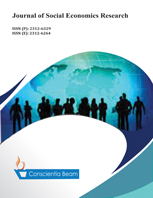Macroeconomic Indicators and Capital Formation Growth in Nigeria: A New Evidence
DOI:
https://doi.org/10.18488/journal.35.2018.52.39.50Abstract
This paper estimates the impact of macroeconomic indicators on the growth of capital formation in Nigeria. Adopting the Autoregressive Distributed Lag Model (ARDL), the empirical findings showed that Foreign aid which is proxied by Overseas Development Assistance (ODA) and Domestic Private Investment (DPI) had positive impact on capital formation growth in Nigeria, while exchange rate, trade openness, and external debt had negative impact for the period under review. The study therefore recommends that aid, especially from the West should not be highly depended upon as a major source of revenue for the development of the economy. Other macroeconomic determinants of capital growth that government should encourage include; savings, investment and the quality of institutions.

